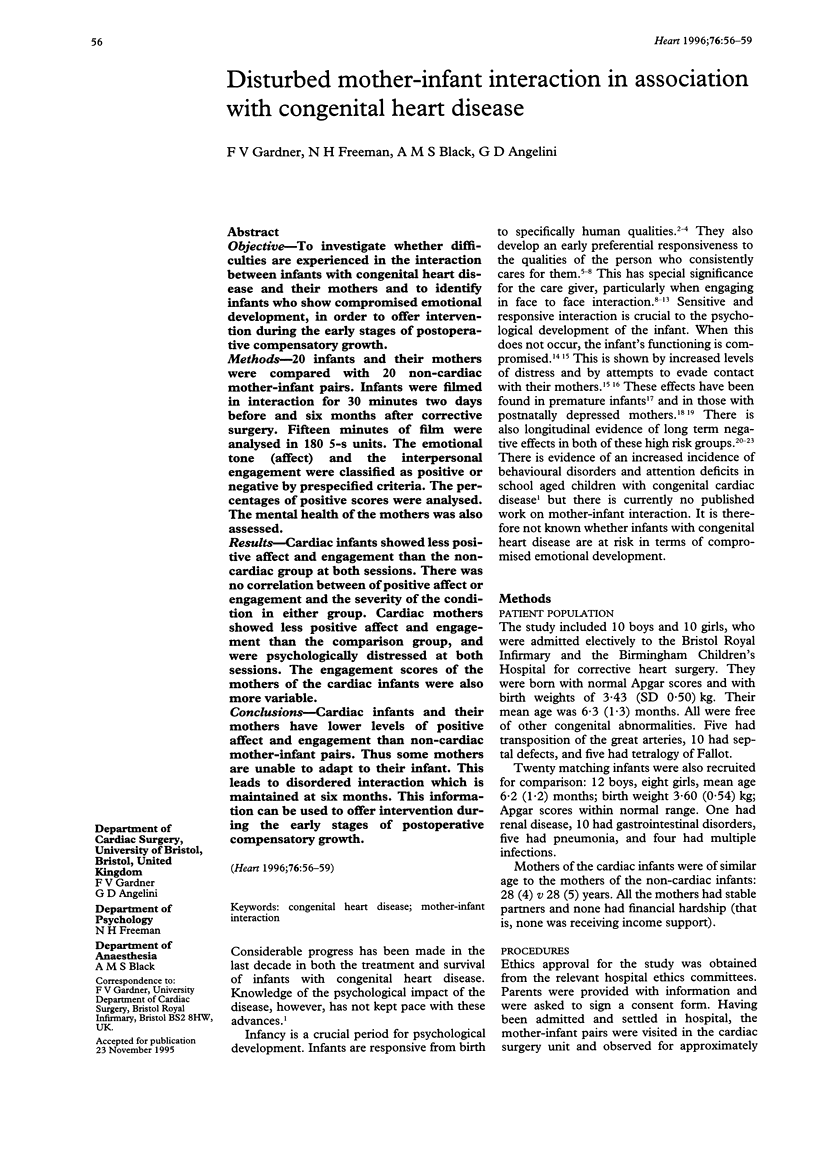Abstract
OBJECTIVE: To investigate whether difficulties are experienced in the interaction between infants with congenital heart disease and their mothers and to identify infants who show compromised emotional development, in order to offer intervention during the early stages of postoperative compensatory growth. METHODS: 20 infants and their mothers were compared with 20 non-cardiac mother-infant pairs. Infants were filmed in interaction for 30 minutes two days before and six months after corrective surgery. Fifteen minutes of film were analysed in 180 5-s units. The emotional tone (affect) and the interpersonal engagement were classified as positive or negative by prespecified criteria. The percentages of positive scores were analysed. The mental health of the mothers was also assessed. RESULTS: Cardiac infants showed less positive affect and engagement than the noncardiac group at both sessions. There was no correlation between of positive affect or engagement and the severity of the condition in either group. Cardiac mothers showed less positive affect and engagement than the comparison group, and were psychologically distressed at both sessions. The engagement scores of the mothers of the cardiac infants were also more variable. CONCLUSIONS: Cardiac infants and their mothers have lower levels of positive affect and engagement than non-cardiac mother-infant pairs. Thus some mothers are unable to adapt to their infant. This leads to disordered interaction which is maintained at six months. This information can be used to offer intervention during the early stages of postoperative compensatory growth.
Full text
PDF



Selected References
These references are in PubMed. This may not be the complete list of references from this article.
- DeCasper A. J., Fifer W. P. Of human bonding: newborns prefer their mothers' voices. Science. 1980 Jun 6;208(4448):1174–1176. doi: 10.1126/science.7375928. [DOI] [PubMed] [Google Scholar]
- Garson A., Jr, Benson R. S., Ivler L., Patton C. Parental reactions to children with congenital heart disease. Child Psychiatry Hum Dev. 1978 Winter;9(2):86–94. doi: 10.1007/BF01448352. [DOI] [PubMed] [Google Scholar]
- Goren C. C., Sarty M., Wu P. Y. Visual following and pattern discrimination of face-like stimuli by newborn infants. Pediatrics. 1975 Oct;56(4):544–549. [PubMed] [Google Scholar]
- Klein M., Stern L. Low birth weight and the battered child syndrome. Am J Dis Child. 1971 Jul;122(1):15–18. doi: 10.1001/archpedi.1971.02110010051005. [DOI] [PubMed] [Google Scholar]
- Loeffel M. Developmental considerations of infants and children with congenital heart disease. Heart Lung. 1985 May;14(3):214–217. [PubMed] [Google Scholar]
- Silbert A., Wolff P. H., Mayer B., Rosenthal A., Nadas A. S. Cyanotic heart disease and psychological development. Pediatrics. 1969 Feb;43(2):192–200. [PubMed] [Google Scholar]
- Tyrer S. P. Learned pain behaviour. Br Med J (Clin Res Ed) 1986 Jan 4;292(6512):1–2. doi: 10.1136/bmj.292.6512.1. [DOI] [PMC free article] [PubMed] [Google Scholar]
- Wrate R. M., Rooney A. C., Thomas P. F., Cox J. L. Postnatal depression and child development. A three-year follow-up study. Br J Psychiatry. 1985 Jun;146:622–627. doi: 10.1192/bjp.146.6.622. [DOI] [PubMed] [Google Scholar]


